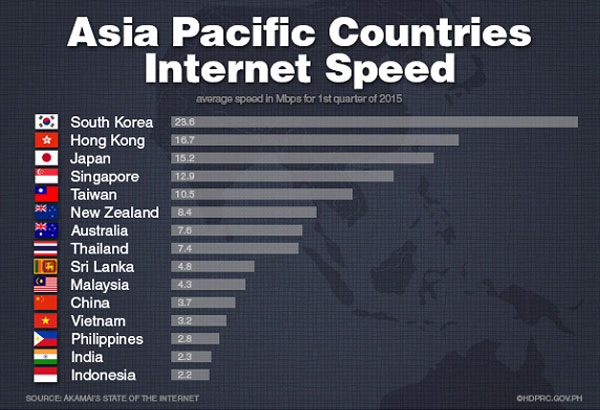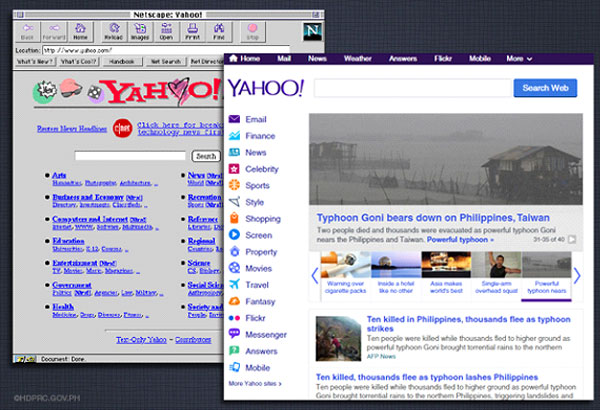Why is our internet so slow?
In 2011, a United Nations report declared internet access to be a basic human right, arguing that disconnecting individuals from the internet was a violation of human rights and international law. So: if internet access is a basic human right, shouldn’t Filipinos be more outraged with the quality—or lack—of service we get from our internet providers?
Many might be surprised that the Philippines was projected to be a leading country in internet-based commerce during the administration of Fidel V Ramos. With our potential and human power to succeed, the National Information and Technology Plan (IT21) set goals for the early 2000s, whereby “human capital and English proficiency” would catapult Filipino comparative advantage. These goals appear to have been lost in translation during subsequent presidential administrations.
Like most social issues, it is easy to equate bad internet to bad politics. Although this relationship may not be causal, internet’s success, nonetheless, relies on a self-regulating economy, integrity of our Internet Service Providers (ISPs), and policies that support these functions. Slow internet would seem to be a symptom of weak policies that can ultimately be improved.
A recent “State of the Internet” report on Asia Pacific done by Akamai, a cloud data network specializing in monitoring internet traffic in real time, shows the Philippines to have the third lowest average connection speed in the region—2.8 Megabits per second (Mbps) for the first quarter of 2015—much lower than the global average connection speed, which is 5 Mbps. Moreover, the Philippines also ranked fourth in terms of lowest peak connection speed, with 20.3 Mbps—far from the global average of 29.1 Mbps.

Yet despite being one of the slowest, internet in the Philippines is one of the most expensive, with a monthly average cost of $18.19 (P848.65) per Mbps—over three times the average global cost of $5.21 (P243.07)—ranking 59th in subscription cost at $31.55 (P1471.97). Indeed, internet service in the Philippines is nearly as expensive as 1 Gigabit per second (Gbps) fiber optic connection in Singapore, which is only $36.01 (P1680) a month.
There are internet services offered here at speeds comparable to Singapore: in high-end Metro Manila villages, both the PLDT and Globe offer 100 Mbps fiber optic connections—for only $428.68 (P20,000) monthly.
A technical autopsy
The internet is a connection of networks designed to share data. Ideally, it is meant to promote openness. This, in turn, is based on cooperation—between individuals, their service providers and their respective countries. It therefore is socio-political and multilateral. However, the internet is often culturally centralized and occasionally government-controlled, compromising openness through the policing of content and restricting the flow of information.Decentralization and openness is more resistant to control and abuse.
We technophobes can perhaps more easily grasp net theory by comparing it to a network of roads spanning national and international borders. Consider your computer to be a vehicle and think of yourself—the driver—carrying your data packages from point A to point B. You can send information anywhere.
Your local roads are built by ISPs like Globe or its more notable rival, PLDT—the parent of other telecoms like SUN and Smart. Each ISP has its own network; the subscribers with different ISPs connect to each other by exchanging traffic, either via private connections or shared internet exchange points. We can consider these toll bridges or crossroads, respectively, through which we must drive to get to point B.
Internet Exchange (IX) is formed when many different organizations—access providers, broadcasters, publishers, social networks, etc.—come together to interconnect their technology. Everyone relying on network traffic benefits from this exchange. Rather than private connection toll booths, subscribers with ISPs connecting in common intersections have lower cost and more highly efficient internet.
The Philippine net: loading… loading…
ISPs, based on telephone-style billing, would charge each other for passage through their networks, like a “toll road” connecting two private roads. However, this charging diminishes internet’s ability to remain open—big companies can gain political control of internet pathways. Despite its inefficiency, this practice continues in the Philippines, where PLDT holds the majority of fee-charging IXs.
The alternative to these unnecessary, costly transactions is “Internet (IP) Peering”: freely sharing platforms to form one connection. IP Peering business relationships allow companies to reciprocally provide access to each other’s customers. ISP providers in ASEAN countries with high-speed internet recognize that peering results in lower costs for all.
Private sector cooperation allows internet’s potential in developing nations to grow. Foreign ISPs that regularly exchange traffic find maintaining a “toll” for private connections or IX more trouble that it’s worth on both private and social levels. PLDT, however, resists efforts to dismantle for-profit IXs—to maintain private control of these connections.
Private sector control endangers the freedom and neutrality of our net. A politically powerful holder of an internet exchange monopoly endangers other competitive ISPs and their subscribers. Thus the government,by allowing a politically powerful company to control IXs, stifles the entire competitive market—forcing high prices and slow speeds on Filipinos.
Ultimately, the more we peer, the freer and faster our internet will become. Unlike other ASEAN countries, the Philippine internet is highly congested due to private “toll roads” needed to bridge networks. Absent IP Peering as a national standard, Philippine internet remains slow and inefficient.
For-profit motivation compounds our IX issues. With PLDT charging to port other network subscribers through their established IX, we are the only country in Asia without a freely functioning, unified exchange point. Singapore runs two IP IXs: Singapore Open Exchange (SOX) and Singapore Internet Exchange (IXP). Although they are not unified, they are efficient, competitive and rapidly growing non-profit IXs. Without a private, central location for “capturing” or blocking a connection, abusive ISPs cannot pass unnecessary costs onto consumers.
Camouflage
Corporate defenders of the status quo like to point out our numerous ISPs—how could our costly internet be a result of monopolist-style control when, in fact, we have more ISPs that Singapore? Unlike our water and electricity, which also out-strip other ASEAN nations in costliness, most areas do indeed have a selection of internet service providers. What remains hidden from public view in the case of ISPs is that all those smaller players must pay toll to PLDT in order to operate—with the costs passed to the end user: you and me. The “last mile” ISP—the company that installs your internet connection—may or may not be controlled by Globe or PLDT. But all ISPs—including Globe—pay PLDT for its IX services.
Globe—unlike most ISPs—has its own national backbone: its own nationwide distribution system--what amounts to the pipes through which our broadband flows. And that indeed amounts to a limited sort of competition between two local giants with similar bottom-line profit motivations. Internet-hungry Filipinos are not, therefore, viewed as a public to serve—rather, they are seen as a resource to exploit. A common business perception is that it is Globe’s ability to compete at the level of national backbone that makes PLDT recalcitrant about its international IX service. What consideration of the public good can be expected from such “competition”?
Privatization of public service is a big demand of neoliberal globalization forces; forces the government—in pursuit of improved foreign investment and trade—is careful to heed. It’s not just the internet. Our water, our electricity, even our public transportation (like MRT) and highways (toll roads) have not only been privatized, but are either deregulated or poorly regulated. In my opinion, the results have been rather uniform in every case: poor service and high cost.
In terms of internet connectivity to the greater world, PLDT remains both the nexus and plexus of our service. Therefore, the investments it makes in physical plant and capital goods in effect control our future. (Ownership and control of PLDT is a subject for a future column.)
Presently, PLDT has reportedly allocated from $50 to $100 million for laying its own sub-sea internet transmission cables, while allocating a mere fraction of that amount to the expansion of faster, more dependable fiber optics to replace troublesome copper wires in the local backbone. Their contention that, because of cost, demand is too low to justify fiber optic expansion seems somewhat disingenuous. Our national backbone facilities are so poor that 70% of our domestic internet traffic is routed through Hong Kong on its way to another domestic user—giving China access to our local messaging and email. A PLDT sub-sea cable will only make that worse, while an expanded fiber optic backbone could make it better.
Addressing the purported lack of demand for fiber optics, the business perception seems to be not that we lack regulation, but that we have the wrong kind of regulation—fees and licenses that cost more than most start-ups can afford to pay. Arguably, that kind of start-up unfriendly regulation could be attributed to the political influence of PLDT and its major stockholders. Sub-sea cables to China strengthen PLDT control—sub-sea fiber optics to our scattered islands could weaken it.
 (Left) Back in the nineties, the internet did not have a lot of bandwidth-intensive graphic and content—256 kbps dial-up internet was sufficient (right). But as the website sophistication evolved, so did its data size. 2 Mbps is today’s internet speed standard.
(Left) Back in the nineties, the internet did not have a lot of bandwidth-intensive graphic and content—256 kbps dial-up internet was sufficient (right). But as the website sophistication evolved, so did its data size. 2 Mbps is today’s internet speed standard. The National Telecommunications Commission (NTC) is the regulating agency responsible for such matters. And it is the NTC that Senator Bam Aquino’s Committee on Trade, Commerce and Entrepreneurship is calling to the fore—lately expressing discontent at the NTC’s failure to deliver on its promise to issue a memorandum circular on the quality of internet standards. Interestingly, what the NTC—for the moment—did do was issue a statement that Public Private Partnerships were the most likely solution to our slow-internet woes.
Senator Aquino’s committee—in aid of legislation discussed below—seems to have a generally favorable impression of the NTC. However, regarding the memorandum circular, the Senator recently remarked, “The NTC must provide a detailed and acceptable report on its recent moves to improve the country’s internet connection service as the approval of their 2016 budget heavily depends on that.”
Unfortunately, rather than mandating a national broadband program or even demanding IP Peering between Globe and PLDT, the legislation now taking shape looks like a disappointing, stop-gap measure: mandating a service minimum of a mere 256 kbps—that’s .256 Mbps, ten times less than the public expectation for a 2 Mbps standard!
Just about the best that can be said of that is that at least it gives us a law to amend—just as the US Federal Communications Commission recently amended their standard from 4 Mbps (considered outdated there) to 20 Mbps.
Two open internet non-profit IXs, PHOpenNIX and the Department of Science and Technology’s PHNET, are already seeking ways toward a more decentralized internet for both urban and rural locations. Evaluating both of them—either in terms of each other or against some PPP program involving foreign participation—is frankly beyond my technological grasp. IP Peering, however, is a big part of any solution—even if it thwarts PLDT’s monopolistic opportunism.
Whether developed locally or with the aid of some foreign corporation, we need a national broadband if we want higher speeds and lower costs. Regulatory care, however, is very much called for. Both the US and China have worrisome internet privacy records. Additionally, regulatory measures should encourage, rather than drive away, start-up competition. Internet start-ups are presently booming worldwide—a boom in which we are not presently participating.
With better—as opposed to simply more—regulation that includes IP Peering, local start-ups and the formation of a true national broadband are within our grasp. But if the public makes no demands and legislators curry up to big-spender favorites, corporate monopoly—in the absence of competition--will continue to keep our internet in its current sorry state.
- Latest
- Trending


























